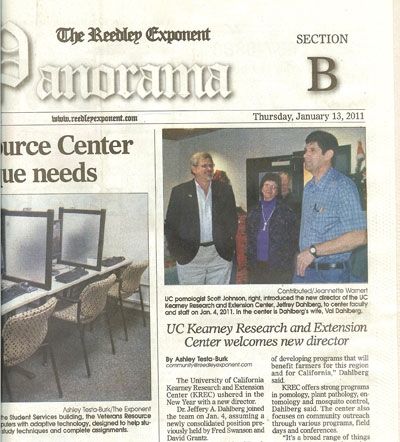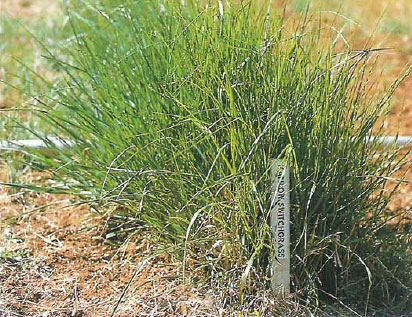Posts Tagged: Jeff Dahlberg
Green energy may generate more greenbacks for farmers
California’s role as an emerging world leader in the development of green energy technologies offers the state’s farmers the opportunity to diversify their cropping systems and increase their income.
Sacramento lawmakers have given the California Energy Commission an annual budget of $100 million to support the development of alternative and renewable low-carbon fuels. In addition, the State Alternative Fuels Plan set goals of reducing petroleum dependence by 15 percent and increasing alternative fuels use by 20 percent by 2020. These efforts are meant to help meet the growing fuel demands of the world population while reducing greenhouse gas emissions in California to 1990 levels.
“With the new mandates, there are new opportunities for using agricultural waste and dedicated energy crops for biofuels, but we’re not yet sure exactly what form it will take,” said UC Cooperative Extension alfalfa specialist Dan Putnam. “I would always encourage growers to experiment with the crop, but I wouldn’t jump in whole hog unless I had a buyer lined up.”
Switchgrass is a potential biofuel crop.
U.S. ethanol production in January 2010 was 818,000 barrels per day, according to the U.S. Energy Information Administration. The United States uses about 20 million barrels of oil per day. If the EPA allows up to 15 percent ethanol blends for all vehicles, then the 10 million barrels per day of oil used by cars and trucks could allow ethanol and biofuels to make up 1.5 million barrels per day.
Cellulosic biomass is the only known resource for the sustainable production of liquid transportation fuels on a large scale and at low costs, according to UC Riverside environmental engineer C. W. Wyman. Cellulosic biomass includes agricultural residues such as corn stems and leaves, forestry residues such as sawdust and paper, landscape waste, herbaceous plants such as switchgrass and sorghum, and woody plants such as poplar trees.
Since a dry ton of cellulosic biomass could provide about three times as much energy as a barrel of petroleum, the cellulosic biomass would have three times the value as a barrel of petroleum. That means cellulosic biomass would be worth about $200 per dry ton when crude oil sells at $65 per barrel.
“To utilize this abundant resource, we must develop low-cost technologies for transforming biomass into fuels that can compete with petroleum,” Wyman wrote in a California Agriculture article “Cellulosic biomass could meet California’s transportation fuel needs.”
Current and potential biomass crops include the grasses switchgrass and miscanthus, other perennial grasses, plus high biomass sorghum, alfalfa and other crops.
Across California, University of California scientists are studying potential biofuel crops. Putnam has four research trials under way, testing varieties from Ceres and Mendel Biotechnology, Inc. He said switchgrass and miscanthus the top contenders so far in his trials.
“The yields of switchgrass under irrigation have been quite high,” Putnam said. “It is an efficient crop for converting solar energy into biomass under warm weather condition.”
Switchgrass does have relatively high water needs. Putname said scientists are looking into whether the crop can be grown under deficit irrigation to save water and still produce the biomass.
“The key issue with biofuels is not necessarily the total water requirement, but the water use efficiency and amount of biomass produced per unit of water,” Putnam said. “Even if a crop has high water use, if it produces a large amount of biomass, it may still be the best option.”
Steve Kaffka and UC Cooperative Extension advisors are involved in research on winter annual oilseeds such as canola, camelina and meadowfoam as potential biofuel feedstock crops.
“Recent economic modeling we have done suggests that at current market prices, canola is a competitive crop in California, but outlets have not yet developed for the seed,” Kaffka said. “Currently, petroleum prices are too low to support the use of canola for biofuel feedstocks, but that is changing rapidly. “
The director of the UC Kearney Research and Extension Center, Jeff Dahlberg, sees opportunities for California production of sorghum as a biofuel crop.
"Sorghum is one of the few crops that span all the different renewable fuel options," he said. "You can use the grain to convert into ethanol. We have sweet sorghum, a specialty sorghum which is very similar to sugar cane. You can press the juice out and convert it into ethanol. And, we can produce a lot of biomass."
Dahlberg previously served as research director for the National Sorghum Producers and the research director for the United Sorghum Checkoff Program in Lubbock, Tex. He currently is lead investigator on a $984,000 U.S. Department of Energy grant to study the composition of sorghum and its potential for cellulosic conversion to biofuel. In addition to continuing this research at Kearney, Dahlberg is interested in developing a center for on-farm green technologies at the Central California research station.
New KREC director explains vision in local newspaper
The new director of the UC Kearney Research and Extension Center, Jeff Dahlberg, shared ideas for the future of the research station in this week's Reedley Exponent.
Dahlberg told reporter Ashley Testa-Burk he is interested in developing 'Centers of Excellence' at Kearney to create a globalized focus spanning county, regional and state lines to benefit farmers across the nation.
“It's much easier to get any kind of federal grant if you have multi-disciplinary, multi-state projects,” Dahlberg was quoted. “So I think by perhaps developing these centers, it might give us a cohesive unit that could actually approach the new federal structure of funding for agriculture.”
Dahlberg also discussed plans for using solar technology at KREC to demonstrate how farmers could reduce their environmental footprint.
“I would like to potentially develop a center for on-farm green technologies in which we could become a demonstration and research site for different technologies that farmers could use to become 'greener,'" he said.
In the article, Dahlberg recognized the profound impact research at Kearney has already made on California agriculture.
“One of my jobs is to get out there and promote the fact that this station is here and it's doing really good work,” he said. “The research not only benefits farmers in this region, but the people of California and ultimately the people of the country.”

Reedley Exponent
Ag radio welcomes new Kearney director
Ag radio personality Sean Michael Lisle of KMJ 580 am based in Fresno welcomed the new director of the UC Kearney Research and Extension Center, Jeff Dahlberg, back to California on this morning's ag radio show.
The program is broadcast from 5 to 6 a.m.; for later risers it can also be downloaded or heard on Californiaagnet.com.
Lisle caught up with Dahlberg at the San Joaquin Valley Grape Symposium in Easton on Wednesday.
Dahlberg told the reporter he is originally from the California Bay Area and spent a lot of time in the Sacramento Valley on his uncles' farms. Most recently, he served as director of the United Sorghum Checkoff Program in Lubbock, Tex.
"I haven't seen fog like this in a long time," he said.
Dahlberg said one idea he brings to Kearney is establishment of centers of excellence.
"I would like to start a center for on-farm green technologies," he said. "How can we bring greener technologies to farmers' fields? How can we use solar (energy) to impact electric costs?"
Dahlberg, a sorghum expert, said he is also interested in studying the crop's potential as a renewable energy crop in California.
"Sorghum is one of the few crops that span all the different renewable fuel options," he said. "You can use the grain to convert into ethanol. We have sweet sorghum, a specialty sorghum which is very similar to sugar cane. You can press the juice out and convert it into ethanol. And, we can produce a lot of biomass."
Sorghum could also be a potential water-saving forage crop, he said.
"Last time I checked, there are still a lot of dairies in this part of the world," Dahlberg said.
Dahlberg told Lisle he sees Kearney as first and foremost a resource to help keep farmers profitable.
"That's a real struggle right now," he said. "We're getting less and less farmers in the country. We need to make sure we keep those numbers up, encourage kids to get into farming. It's a good life and you can make some money doing it."



